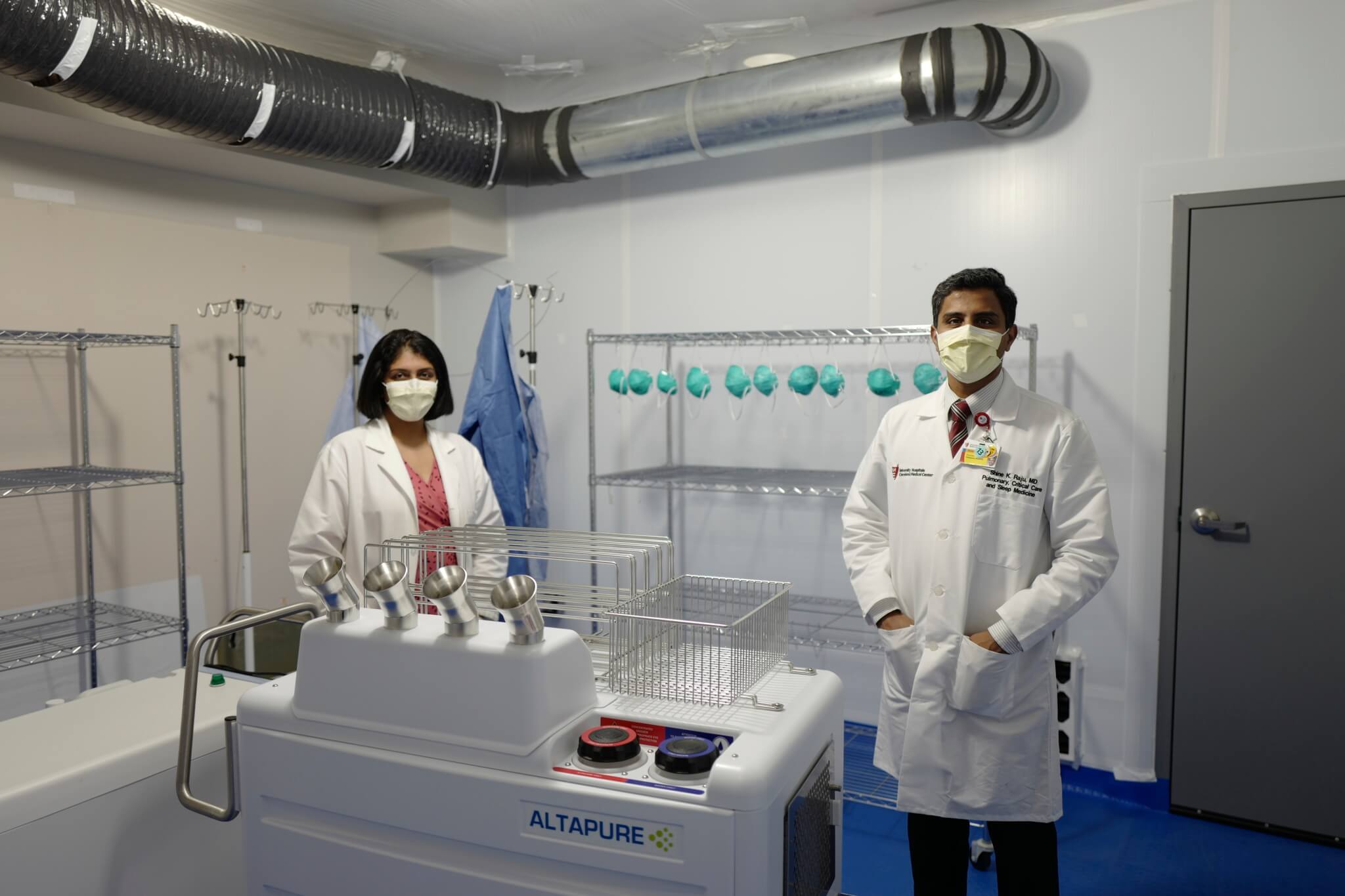Preparing for COVID-19 Surge or Future Pandemic
November 11, 2020
Critical care clinicians research better ways of protecting staff and patients
Innovations in Pulmonology & Sleep Medicine | Fall 2020
 Shine Raju, MD
Shine Raju, MD Amrita John, MD
Amrita John, MDEarly in the year, Shine Raju, MD, Division of Pulmonary, Critical Care and Sleep Medicine, University Hospitals Cleveland Medical Center, and Assistant Professor, Case Western Reserve University School of Medicine, and his wife and colleague, infectious disease and critical care expert Amrita John, MD, discussed how to keep their young children safe while they were caring for COVID-19 patients.
Their personal musings prompted them to reach out to the Infectious Disease team, which quickly led to their leadership in several research projects about how to effectively decontaminate N95 masks for multiple use, potentially preempting a shortage of masks.
BORROWING FROM THE FOOD INDUSTRY
In partnership with UH Ventures, the innovation and commercialization arm of University Hospitals, the U.S. Department of Veterans Affairs (VA), and Case Western Reserve University, Dr. Raju and Dr. John began examining whether peracetic acid, an EPA-approved chemical disinfectant commonly used in the food industry, would decontaminate N95 masks.
“Before this pandemic, there were no FDA-approved decontamination processes for N95 respirators,” Dr. Raju explains. “We partnered with Altapure, a company that uses advanced ultrasound technology to generate peracetic acid aerosols. Altapure was already using their machine in decontamination studies at the VA, so we brought it to UH and set up a new decontamination room in the sub-basement. After five months of research, we’ve made a lot of progress.”
Dr. Raju says their research shows peracetic acid kills 99.9999 percent of viruses and highly resistant bacterial spores from contaminated N95 masks for up to five cycles of decontamination without compromising the fit, form or filtration efficiency of the mask. Peracetic acid overcomes the key shortcoming of using alcohol-based disinfectants, routinely used in hospitals, because it doesn’t cause electrical charges in the mask to decay, compromising the mask’s filtration efficiency.
Altapure has applied to the U.S. Food and Drug Administration (FDA) for an Emergency Use Authorization (EUA) to use peracetic acid for N95 decontamination.
“If the FDA approves the EUA, UH and Altapure will be one of only three or four organizations in the U.S. to get this distinction,” Dr. Raju says. “That would be an amazing achievement and proud moment for all of us. Our research has also been accepted for publication in an esteemed peer-reviewed medical journal.”
Dr. Raju and Dr. John are exploring whether this technology can also be used to decontaminate larger medical equipment, such as ventilators, which are difficult and labor intensive to clean because of their intricately modeled surfaces.
In another partnership, UH is working with Cres Cor, a company that manufactures heat and humidity cabinets for the restaurant industry, to determine if these cabinets might also have the potential to disinfect masks and hospital equipment.
“The research is impressive,” Dr. Raju says. “This machine has not been used for this purpose [cleaning masks] and has never been used in a hospital outside its traditional application, but we’ve found a new use for it. Cres Cor has also applied for an FDA EUA, which is currently in review.”
UH was fully prepared with adequate masks and personal protective equipment to handle its load of COVID-19 patients. However, through this research, UH is proactively planning ahead for a potential resurgence of coronavirus cases or a future health crisis.
SPACE-AGE CLEANER: ATOMIC OXYGEN
A collaboration with NASA’s Glenn Research Center has led to another avenue of research: determining if atomic oxygen, used in spacecraft cleaning and decontamination, would also work for decontaminating N95 masks, Dr. Raju says. As a gas, atomic oxygen envelops the entire mask, including difficult-to-reach areas, and can remove stubborn organic material from the surface of the mask.
 Dr. Shine Raju and Dr. Amrita John with the peracetic aerosolization device.
Dr. Shine Raju and Dr. Amrita John with the peracetic aerosolization device.Preliminary tests show that the tested atomic oxygen prototype is highly effective for decontamination, but more research is needed to establish decontamination parameters that can effectively disinfect, while maintaining the structural integrity of the mask.
MULTIDISCIPLINARY COLLABORATION LEADS TO INNOVATION
Dr. Raju says bringing together disparate sources of expertise and forging partnerships with non-medical organizations has been the most remarkable part of the last five months.
“We’ve brought together experts to find a solution for a very difficult problem,” he says. “I’ve also had the opportunity to interact and make friends with electricians, plumbers, engineers — people I would have never worked with in another situation. Their expertise was key for the successful completion of our research.”
Dr. Raju notes that the forward-thinking leadership at UH and its generous allocation of resources has been a critical component to undertaking this research and accomplishing so much in such a short time.
“With this kind of support,” he says, “we can really do great things!”
For more information about any of these research studies, call Dr. Raju at 216-593-5864.


